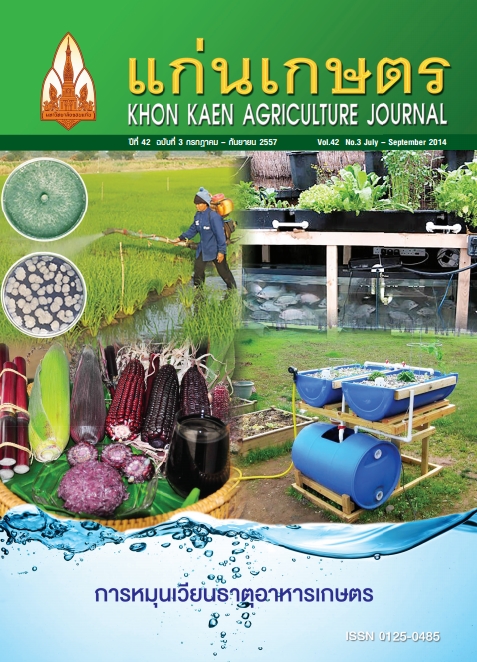Physiological responses to cutaneous evaporative heat loss in Bos indicus, Bos taurus, and their crossbreds
Main Article Content
บทคัดย่อ
Cutaneous evaporative heat loss in Bos indicus and Bos taurus has been well documented. Nonetheless, how crossbreds with different fractional genetic proportions respond to such circumstances is of interest. A study to examine the physiological responses to cutaneous evaporative heat loss was conducted in Sahiwal (Bos indicus, n=5, 444±64.8 kg, 9±2.9 years), Holstein Friesian (Bos taurus, HF 100%, n=5, 488±97.9 kg, 6±2.8 years), and the following crossbreds: HF 50% (n=5, 355±40.7 kg, 2±0 years), and HF 87.5% (n=5, 489±76.8 kg, 7±1.8 years). They were allocated so as to determine the physiological responses of sweating rate (SR), respiration rate (RR), rectal temperature (RT), and skin temperature (ST) with and without hair from 6.00 am to 3.00 pm. The ambient temperature-humidity index (THI) increased from less than 80 in the early morning to more than 90 in the late afternoon. The interaction of THI and breed highly affected SR, RR, RT, and ST (P<0.01). SR was highest in Sahiwal (595 g/m-2.h-1) compared to HF 100% (227 g/m-2.h-1) and their crossbreds: both HF 50% (335 g/m-2.h-1) and HF 87.5% (299 g/m-2.h-1). On the other hand, RR was higher in HF 87.5% (54bpm), HF 100% (48bpm), and HF 50% (42bpm) than Sahiwal (25bpm) (P<0.01). RT showed no significant differences as a result of breed (P>0.05) but did change over time. ST with and without hair were similar, and were higher in HF 100% (37.4°C, 38.0°C) and their crossbreds: HF 50% (35.5°C, 35.5°C) and HF 87.5% (37.1°C, 37.9°C), than Sahiwal (34.8°C, 34.8°C) (P<0.01). In conclusion, sweating and respiration were the main vehicles for dissipating excess body heat for Sahiwal, and HF and crossbreds, respectively. THI at 76 to 80 were the critical points where the physiological responses to elevated temperature displayed change.

